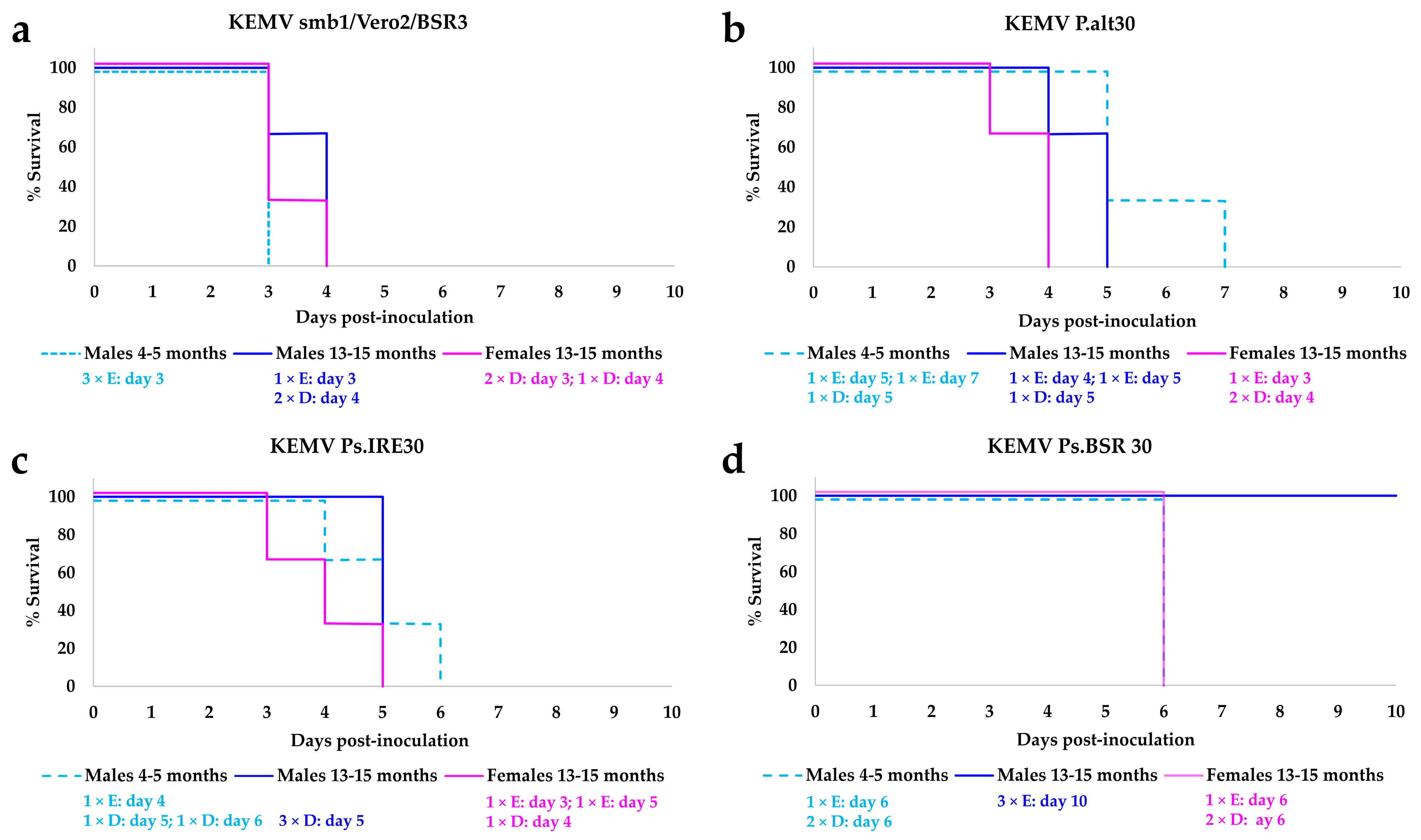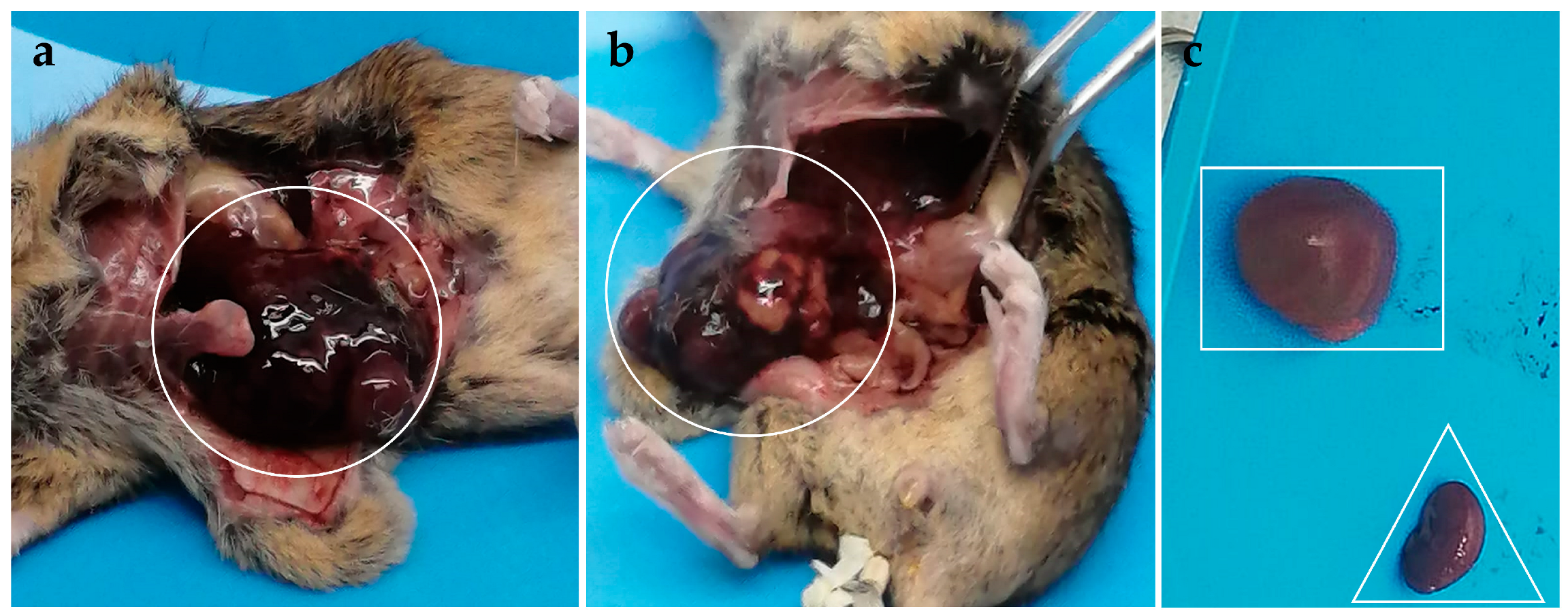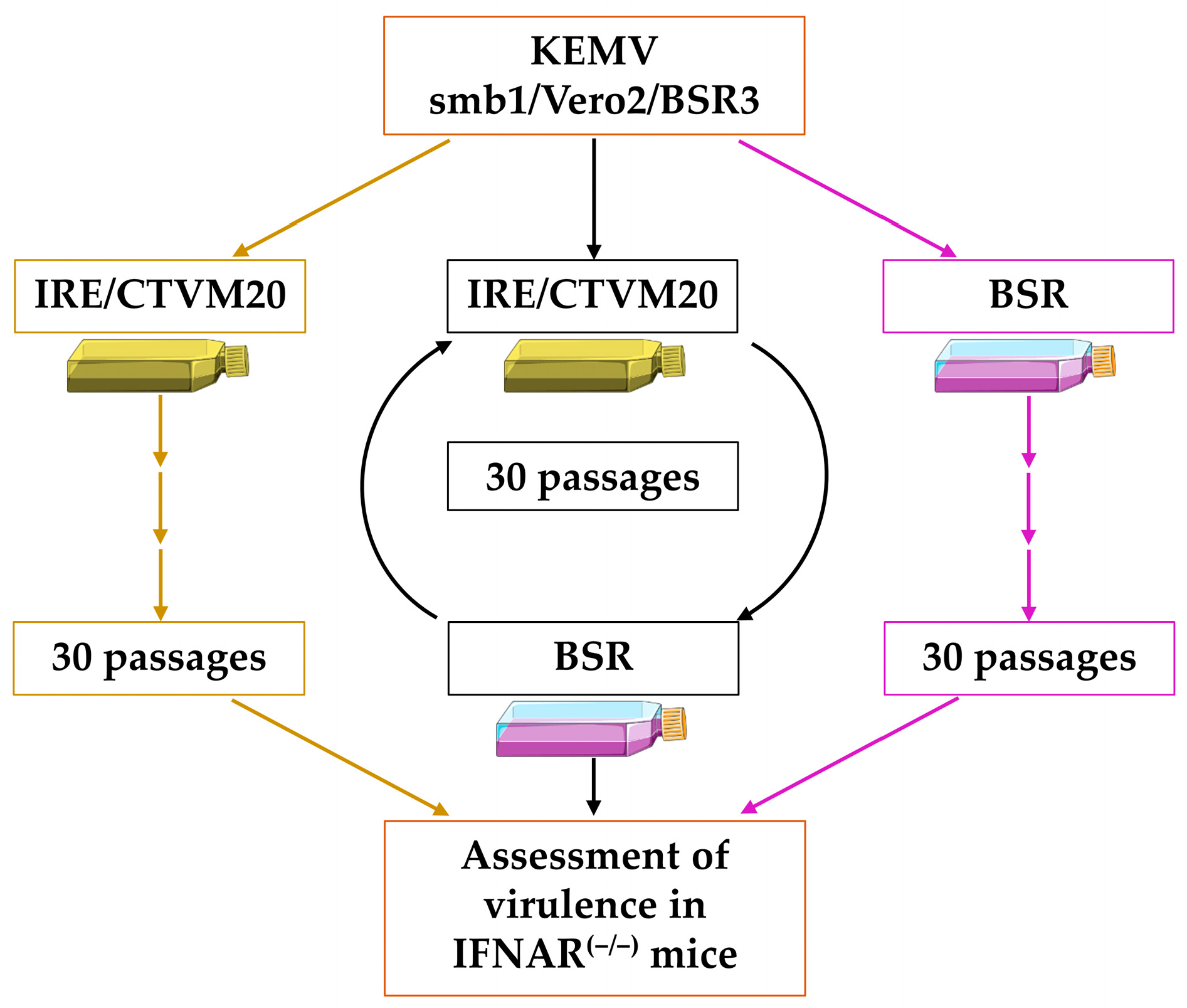Age- and Sex-Associated Pathogenesis of Cell Culture-Passaged Kemerovo Virus in IFNAR(−/−) Mice
Abstract
1. Introduction
2. Results and Discussion
2.1. Minimal Infective Dose of KEMV in IFNAR(−/−) Mice
2.2. Virulence of KEMV Passaged in Mammalian or Tick Cells or by Alternation between the Two Cell Systems
2.3. Replication of KEMV in Mouse Organs
2.4. Sequencing of the Parental KEMV smb1/Vero2/BSR3 and KEMV Ps.IRE1
3. Materials and Methods
3.1. Cell Lines, Virus and Mice
3.2. Virus Release from Cells/Cell Debris and Titration
3.3. Passages of KEMV in BSR and/or IRE/CTVM20 Cells
3.4. Determination of the Minimal Infective Dose of KEMV in IFNAR(−/−) Mice
3.5. Assessing Virus Phenotype in IFNAR(−/−) Mice
3.6. Detecting Viral RNA in Mouse Samples
3.7. Sequencing of the Parental KEMV smb1/Vero2/BSR3 and KEMV Ps.IRE1 Genomes
4. Conclusions
Supplementary Materials
Author Contributions
Funding
Institutional Review Board Statement
Informed Consent Statement
Data Availability Statement
Acknowledgments
Conflicts of Interest
References
- Libikova, H.; Tesarova, J.; Rajcani, J. Experimental infection of monkeys with Kemerovo virus. Acta Virol. 1970, 14, 64–69. [Google Scholar] [PubMed]
- Karabatsos, N. International Catalogue of Arboviruses including Certain Other Viruses of Vertebrates, 3rd ed.; American Society of Tropical Medicine and Hygiene: San Antonio, TX, USA, 1985. [Google Scholar]
- Semashko, I. Comparative Investigation of the Kemerovo Serological Group Members. Ph.D. Thesis, . Moscow, Russia, 1971. [Google Scholar]
- Labuda, M.; Nuttall, P.A. Tick-borne viruses. Parasitology 2004, 129, S221–S245. [Google Scholar] [CrossRef] [PubMed]
- Mansfield, K.L.; Jizhou, L.; Phipps, L.P.; Johnson, N. Emerging Tick-Borne Viruses in the Twenty-First Century. Front. Cell Infect. Microbiol. 2017, 7, 298. [Google Scholar] [CrossRef]
- Belhouchet, M.; Mohd Jaafar, F.; Tesh, R.; Grimes, J.; Maan, S.; Mertens, P.P.; Attoui, H. Complete sequence of Great Island virus and comparison with the T2 and outer-capsid proteins of Kemerovo, Lipovnik and Tribec viruses (genus Orbivirus, family Reoviridae). J. Gen. Virol. 2010, 91, 2985–2993. [Google Scholar] [CrossRef] [PubMed]
- Gresikova, M.; Rajcani, J.; Hruzik, J. Pathogenicity of Tribec virus for Macaca rhesus monkeys and white mice. Acta Virol. 1966, 10, 420–424. [Google Scholar] [PubMed]
- Migne, C.V.; Braga de Seixas, H.; Heckmann, A.; Galon, C.; Mohd Jaafar, F.; Monsion, B.; Attoui, H.; Moutailler, S. Evaluation of Vector Competence of Ixodes Ticks for Kemerovo Virus. Viruses 2022, 14, 1102. [Google Scholar] [CrossRef]
- Alonso, C.; Utrilla-Trigo, S.; Calvo-Pinilla, E.; Jimenez-Cabello, L.; Ortego, J.; Nogales, A. Inhibition of Orbivirus Replication by Aurintricarboxylic Acid. Int. J. Mol. Sci. 2020, 21, 7294. [Google Scholar] [CrossRef] [PubMed]
- Calvo-Pinilla, E.; de la Poza, F.; Gubbins, S.; Mertens, P.P.; Ortego, J.; Castillo-Olivares, J. Antiserum from mice vaccinated with modified vaccinia Ankara virus expressing African horse sickness virus (AHSV) VP2 provides protection when it is administered 48h before, or 48h after challenge. Antiviral Res. 2015, 116, 27–33. [Google Scholar] [CrossRef]
- Calvo-Pinilla, E.; Rodriguez-Calvo, T.; Sevilla, N.; Ortego, J. Heterologous prime boost vaccination with DNA and recombinant modified vaccinia virus Ankara protects IFNAR(-/-) mice against lethal bluetongue infection. Vaccine 2009, 28, 437–445. [Google Scholar] [CrossRef]
- Jabbar, T.K.; Calvo-Pinilla, E.; Mateos, F.; Gubbins, S.; Bin-Tarif, A.; Bachanek-Bankowska, K.; Alpar, O.; Ortego, J.; Takamatsu, H.H.; Mertens, P.P.; et al. Protection of IFNAR (-/-) mice against bluetongue virus serotype 8, by heterologous (DNA/rMVA) and homologous (rMVA/rMVA) vaccination, expressing outer-capsid protein VP2. PLoS ONE 2013, 8, e60574. [Google Scholar] [CrossRef]
- Migliore, L.; Nicoli, V.; Stoccoro, A. Gender Specific Differences in Disease Susceptibility: The Role of Epigenetics. Biomedicines 2021, 9, 652. [Google Scholar] [CrossRef]
- Kloc, M.; Ghobrial, R.M.; Kubiak, J.Z. The Role of Genetic Sex and Mitochondria in Response to COVID-19 Infection. Int. Arch. Allergy Immunol. 2020, 181, 629–634. [Google Scholar] [CrossRef]
- Schurz, H.; Salie, M.; Tromp, G.; Hoal, E.G.; Kinnear, C.J.; Moller, M. The X chromosome and sex-specific effects in infectious disease susceptibility. Hum. Genom. 2019, 13, 2. [Google Scholar] [CrossRef]
- Krementsov, D.N.; Case, L.K.; Dienz, O.; Raza, A.; Fang, Q.; Ather, J.L.; Poynter, M.E.; Boyson, J.E.; Bunn, J.Y.; Teuscher, C. Genetic variation in chromosome Y regulates susceptibility to influenza A virus infection. Proc. Natl. Acad. Sci. USA 2017, 114, 3491–3496. [Google Scholar] [CrossRef] [PubMed]
- Rivarola, M.E.; Tauro, L.B.; Llinas, G.A.; Contigiani, M.S. Virulence variation among epidemic and non-epidemic strains of Saint Louis encephalitis virus circulating in Argentina. Mem. Inst. Oswaldo Cruz 2014, 109, 197–201. [Google Scholar] [CrossRef]
- Kopanke, J.H.; Lee, J.S.; Stenglein, M.D.; Mayo, C.E. The Genetic Diversification of a Single Bluetongue Virus Strain Using an In Vitro Model of Alternating-Host Transmission. Viruses 2020, 12, 1038. [Google Scholar] [CrossRef] [PubMed]
- Lean, F.Z.X.; Neave, M.J.; White, J.R.; Payne, J.; Eastwood, T.; Bergfeld, J.; Di Rubbo, A.; Stevens, V.; Davies, K.R.; Devlin, J.; et al. Attenuation of Bluetongue Virus (BTV) in an in ovo Model Is Related to the Changes of Viral Genetic Diversity of Cell-Culture Passaged BTV. Viruses 2019, 11, 481. [Google Scholar] [CrossRef] [PubMed]
- Alpar, H.O.; Bramwell, V.W.; Veronesi, E.; Darpel, K.E.; Pastoret, P.P.; Mertens, P.P.C. Bluetongue virus vaccines past and present. In Bluetongue; Mellor, P.S., Baylis, M., Mertens, P.P.C., Eds.; Academic Press: Cambridge, MA, USA, 2009; pp. 397–428. [Google Scholar]
- Zarbl, H.; Millward, S. The reovirus multiplication cycle. In The Reoviridae; Joklik, W.K., Ed.; Plenum Press: New York, NY, USA, 1983; pp. 107–196. [Google Scholar]
- Attoui, H.; Mohd Jaafar, F.; Monsion, B.; Klonjkowski, B.; Reid, E.; Fay, P.C.; Saunders, K.; Lomonossoff, G.; Haig, D.; Mertens, P.P.C. Increased Clinical Signs and Mortality in IFNAR(-/-) Mice Immunised with the Bluetongue Virus Outer-Capsid Proteins VP2 or VP5, after Challenge with an Attenuated Heterologous Serotype. Pathogens 2023, 12, 602. [Google Scholar] [CrossRef] [PubMed]
- Pandey, A.; Dawson, D.E. The shapes of virulence to come. Evol. Med. Public. Health 2019, 2019, 3. [Google Scholar] [CrossRef]
- Bruenn, J.A. Relationships among the positive strand and double-strand RNA viruses as viewed through their RNA-dependent RNA polymerases. Nucleic Acids Res. 1991, 19, 217–226. [Google Scholar] [CrossRef]
- Attoui, H.; Mertens, P.P.C.; Becnel, J.; Belaganahalli, S.; Bergoin, M.; Brussaard, C.P.; Chappell, J.D.; Ciarlet, M.; del Vas, M.; Dermody, T.S.; et al. Reoviridae. In Virus Taxonomy; King, A.M.Q., Adams, M.J., Carstens, E.B., Lefkowitz, E.J., Eds.; Elsevier: Amsterdam, The Netherlands, 2012; pp. 541–637. [Google Scholar]
- Poch, O.; Sauvaget, I.; Delarue, M.; Tordo, N. Identification of four conserved motifs among the RNA-dependent polymerase encoding elements. EMBO J. 1989, 8, 3867–3874. [Google Scholar] [CrossRef]
- Sato, M.; Maeda, N.; Yoshida, H.; Urade, M.; Saito, S. Plaque formation of herpes virus hominis type 2 and rubella virus in variants isolated from the colonies of BHK21/WI-2 cells formed in soft agar. Arch. Virol. 1977, 53, 269–273. [Google Scholar] [CrossRef]
- Bell-Sakyi, L.; Mohd Jaafar, F.; Monsion, B.; Luu, L.; Denison, E.; Carpenter, S.; Attoui, H.; Mertens, P.P.C. Continuous Cell Lines from the European Biting Midge Culicoides nubeculosus (Meigen, 1830). Microorganisms 2020, 8, 825. [Google Scholar] [CrossRef]
- Muller, U.; Steinhoff, U.; Reis, L.F.; Hemmi, S.; Pavlovic, J.; Zinkernagel, R.M.; Aguet, M. Functional role of type I and type II interferons in antiviral defense. Science 1994, 264, 1918–1921. [Google Scholar] [CrossRef]
- Castillo-Olivares, J.; Calvo-Pinilla, E.; Casanova, I.; Bachanek-Bankowska, K.; Chiam, R.; Maan, S.; Nieto, J.M.; Ortego, J.; Mertens, P.P. A modified vaccinia Ankara virus (MVA) vaccine expressing African horse sickness virus (AHSV) VP2 protects against AHSV challenge in an IFNAR -/- mouse model. PLoS ONE 2011, 6, e16503. [Google Scholar] [CrossRef]
- Utrilla-Trigo, S.; Jimenez-Cabello, L.; Calvo-Pinilla, E.; Marin-Lopez, A.; Lorenzo, G.; Sanchez-Cordon, P.; Moreno, S.; Benavides, J.; Gilbert, S.; Nogales, A.; et al. The Combined Expression of the Nonstructural Protein NS1 and the N-Terminal Half of NS2 (NS2(1-180)) by ChAdOx1 and MVA Confers Protection against Clinical Disease in Sheep upon Bluetongue Virus Challenge. J. Virol. 2022, 96, e0161421. [Google Scholar] [CrossRef] [PubMed]
- Burroughs, J.N.; O’Hara, R.S.; Smale, C.J.; Hamblin, C.; Walton, A.; Armstrong, R.; Mertens, P.P. Purification and properties of virus particles, infectious subviral particles, cores and VP7 crystals of African horsesickness virus serotype 9. J. Gen. Virol. 1994, 75, 1849–1857. [Google Scholar] [CrossRef] [PubMed]
- Mertens, P.P.; Burroughs, J.N.; Anderson, J. Purification and properties of virus particles, infectious subviral particles, and cores of bluetongue virus serotypes 1 and 4. Virology 1987, 157, 375–386. [Google Scholar] [CrossRef] [PubMed]
- Caddy, S.L.; Vaysburd, M.; Wing, M.; Foss, S.; Andersen, J.T.; O’Connell, K.; Mayes, K.; Higginson, K.; Iturriza-Gómara, M.; Desselberger, U.; et al. Intracellular neutralisation of rotavirus by VP6-specific IgG. PLoS. Pathog. 2020, 16, e1008732. [Google Scholar] [CrossRef] [PubMed]
- Calvo-Pinilla, E.; Rodriguez-Calvo, T.; Anguita, J.; Sevilla, N.; Ortego, J. Establishment of a bluetongue virus infection model in mice that are deficient in the alpha/beta interferon receptor. PLoS ONE 2009, 4, e5171. [Google Scholar] [CrossRef] [PubMed]
- Gondard, M.; Michelet, L.; Nisavanh, A.; Devillers, E.; Delannoy, S.; Fach, P.; Aspan, A.; Ullman, K.; Chirico, J.; Hoffmann, B.; et al. Prevalence of tick-borne viruses in Ixodes ricinus assessed by high-throughput real-time PCR. Pathog. Dis. 2018, 76, 8. [Google Scholar] [CrossRef] [PubMed]
- Attoui, H.; Billoir, F.; Cantaloube, J.F.; Biagini, P.; de Micco, P.; de Lamballerie, X. Strategies for the sequence determination of viral dsRNA genomes. J. Virol. Methods 2000, 89, 147–158. [Google Scholar] [CrossRef] [PubMed]
- Larkin, M.A.; Blackshields, G.; Brown, N.P.; Chenna, R.; McGettigan, P.A.; McWilliam, H.; Valentin, F.; Wallace, I.M.; Wilm, A.; Lopez, R.; et al. Clustal W and Clustal X version 2.0. Bioinformatics 2007, 23, 2947–2948. [Google Scholar] [CrossRef]
- Tamura, K.; Stecher, G.; Kumar, S. MEGA11: Molecular Evolutionary Genetics Analysis Version 11. Mol. Biol. Evol. 2021, 38, 3022–3027. [Google Scholar] [CrossRef]
- Ananth, S.; Shrestha, N.; Trevino, C.J.; Nguyen, U.S.; Haque, U.; Angulo-Molina, A.; Lopez-Lemus, U.A.; Lubinda, J.; Sharif, R.M.; Zaki, R.A.; et al. Clinical Symptoms of Arboviruses in Mexico. Pathogens 2020, 9, 964. [Google Scholar] [CrossRef] [PubMed]



| Organs | KEMV smb1/Vero2/BSR3 | KEMV P.alt30 | KEMV Ps.BSR30 | KEMV Ps.IRE30 |
|---|---|---|---|---|
| Spleen | No splenomegaly. White/yellow spots. | Splenomegaly. White/yellow spots or entirely yellowish. | Splenomegaly. White/yellow or fully yellowish. | Splenomegaly. White/yellow spots or fully yellowish. |
| Liver | Slightly enlarged. Discoloured. | Slightly enlarged. Discoloured. | Slightly enlarged. Discoloured. 13–15-month-old males did not show observable changes in their liver. | Hepatomegaly *. Discoloured. |
| Kidneys | Nephromegaly * (one young male only). | Normal appearance. | Normal appearance. | Normal appearance. |
| Organs | Males (13–15 Months) Inoculated with KEMV Ps.BSR30 (n = 3) | Females (13–15 Months) Inoculated with KEMV Ps.BSR30 (n = 1) * | Males (4–5 Months) Inoculated with KEMV Ps.BSR30 (n = 1) * |
|---|---|---|---|
| Liver | +(35.20) | +(28.53) | +(27.94) |
| Spleen | +(31.14) | +(22.32) | +(23.68) |
| Lungs | +(35.29) | +(28.03) | +(29.48) |
| Kidneys | +(36.84) | +(29.86) | +(31.59) |
| Heart | - | +(32.39) | +(32.05) |
| Brain | +(37.35) | +(34.72) | +(33.64) |
| Blood | +(34.84) (3 mice) | +(36.01) (3 mice) | +(34.86) (3 mice) |
| Organs | Males (13–15 Months) Inoculated with KEMV smb1/Vero2/BSR3 (n = 1) * | Males (4–5 Months) Inoculated with KEMV smb1/Vero2/BSR3 (n = 3) |
|---|---|---|
| Liver | +(21.46) | +(22.73) |
| Spleen | +(19.08) | +(19.42) |
| Lungs | +(22.39) | +(22.94) |
| Kidneys | +(23.25) | +(24.81) |
| Heart | +(26.15) | +(26.24) |
| Brain | +(28.41) | +(29.59) |
| Blood | +(28.76) (3 mice) | +(27.51) (3 mice) |
| Organs | Males (13–15 Months) Inoculated with KEMV P.alt30 (n = 2) * | Females (13–15 Months) Inoculated with KEMV P.alt30 (n = 1) * | Males (4–5 Months) Inoculated with KEMV P.alt30 (n = 2) * |
|---|---|---|---|
| Liver | +(25.47) | +(28.08) | +(24.59) |
| Spleen | +(20.53) | +(20.88) | +(21.75) |
| Lungs | +(28.03) | +(27.12) | +(26.19) |
| Kidneys | +(28.05) | +(30.05) | +(28.70) |
| Heart | +(29.53) | +(32.17) | +(30.63) |
| Brain | +(32.75) | +(33.32) | +(32.02) |
| Blood | +(31.62) (3 mice) | +(29.26) (3 mice) | +(30.05) (3 mice) |
| Organs | Females (13–15 Months) Inoculated with KEMV Ps.IRE30 (n = 1) * | Males (4–5 Months) Inoculated with KEMV Ps.IRE30 (n = 2) * |
|---|---|---|
| Liver | +(29.80) | +(27.35) |
| Spleen | +(23.74) | +(22.65) |
| Lungs | +(26.76) | +(29.53) |
| Kidneys | +(30.93) | +(29.17) |
| Heart | +(32.31) | +(31.45) |
| Brain | +(33.73) | +(33.77) |
| Blood | +(33.16) (3 mice) | +(32.28) (3 mice) |
| Number of PFU | Total Number of Mice | Sex | |
|---|---|---|---|
| Female | Male | ||
| 104 | 2 | 2 | 0 |
| 103 | 2 | 1 | 1 |
| 102 | 2 | 1 | 1 |
| 10 | 2 | 1 | 1 |
| 1 | 2 | 0 | 2 |
| 0.1 | 2 | 0 | 2 |
Disclaimer/Publisher’s Note: The statements, opinions and data contained in all publications are solely those of the individual author(s) and contributor(s) and not of MDPI and/or the editor(s). MDPI and/or the editor(s) disclaim responsibility for any injury to people or property resulting from any ideas, methods, instructions or products referred to in the content. |
© 2024 by the authors. Licensee MDPI, Basel, Switzerland. This article is an open access article distributed under the terms and conditions of the Creative Commons Attribution (CC BY) license (https://creativecommons.org/licenses/by/4.0/).
Share and Cite
Migné, C.V.; Heckmann, A.; Monsion, B.; Mohd Jaafar, F.; Galon, C.; Rakotobe, S.; Bell-Sakyi, L.; Moutailler, S.; Attoui, H. Age- and Sex-Associated Pathogenesis of Cell Culture-Passaged Kemerovo Virus in IFNAR(−/−) Mice. Int. J. Mol. Sci. 2024, 25, 3177. https://doi.org/10.3390/ijms25063177
Migné CV, Heckmann A, Monsion B, Mohd Jaafar F, Galon C, Rakotobe S, Bell-Sakyi L, Moutailler S, Attoui H. Age- and Sex-Associated Pathogenesis of Cell Culture-Passaged Kemerovo Virus in IFNAR(−/−) Mice. International Journal of Molecular Sciences. 2024; 25(6):3177. https://doi.org/10.3390/ijms25063177
Chicago/Turabian StyleMigné, Camille Victoire, Aurélie Heckmann, Baptiste Monsion, Fauziah Mohd Jaafar, Clémence Galon, Sabine Rakotobe, Lesley Bell-Sakyi, Sara Moutailler, and Houssam Attoui. 2024. "Age- and Sex-Associated Pathogenesis of Cell Culture-Passaged Kemerovo Virus in IFNAR(−/−) Mice" International Journal of Molecular Sciences 25, no. 6: 3177. https://doi.org/10.3390/ijms25063177
APA StyleMigné, C. V., Heckmann, A., Monsion, B., Mohd Jaafar, F., Galon, C., Rakotobe, S., Bell-Sakyi, L., Moutailler, S., & Attoui, H. (2024). Age- and Sex-Associated Pathogenesis of Cell Culture-Passaged Kemerovo Virus in IFNAR(−/−) Mice. International Journal of Molecular Sciences, 25(6), 3177. https://doi.org/10.3390/ijms25063177








